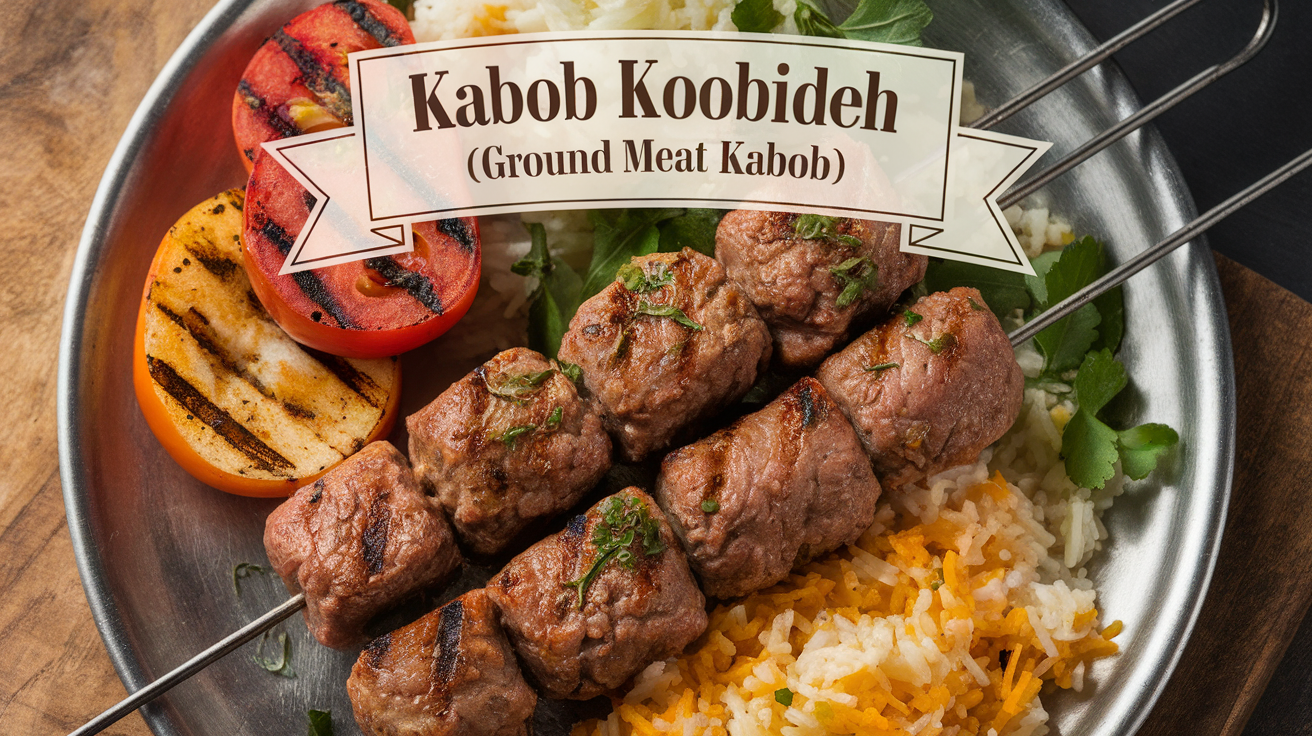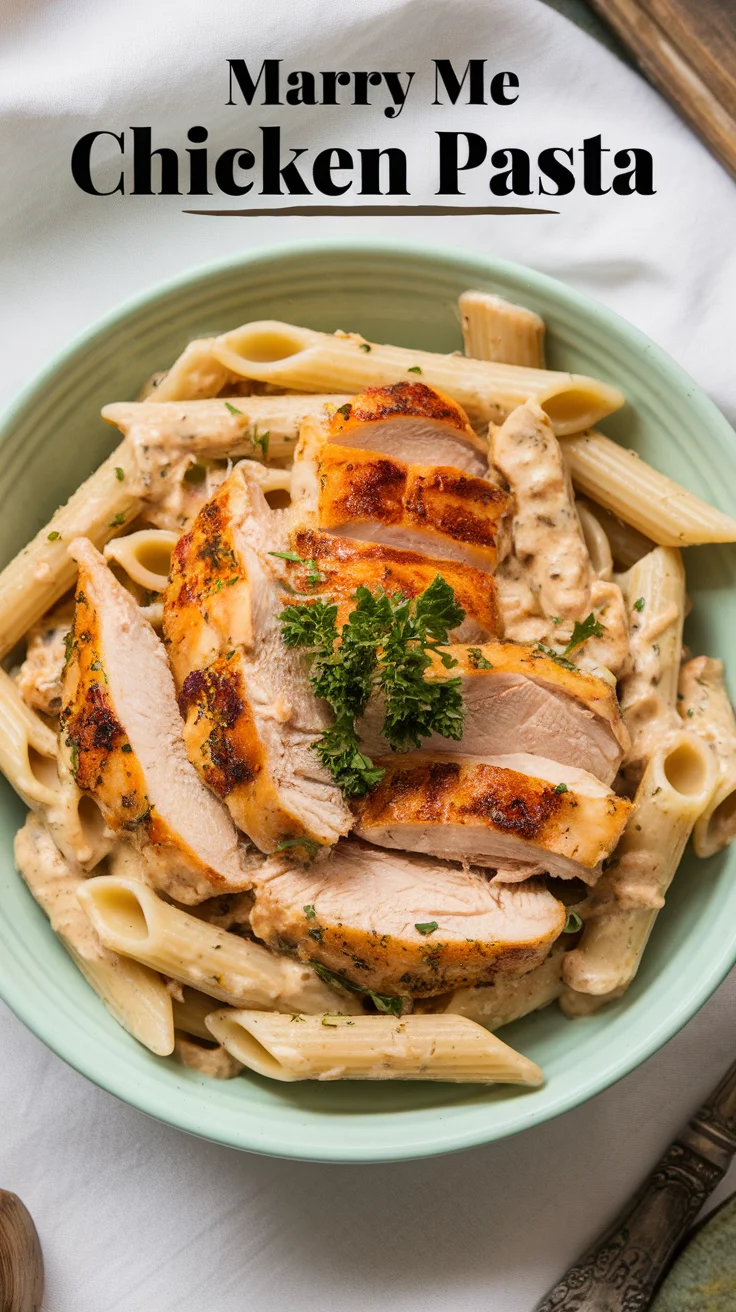Kabob Koobideh, also known as Koobideh kebab, is one of the most beloved and famous dishes in Persian cuisine. This flavorful, savory meat dish has been a staple in Iranian homes for centuries, bringing together the best of Persian spices, tender ground meat, and a traditional cooking method that enhances the taste and texture. Kabob Koobideh is the go-to meal for family gatherings, celebrations, and everyday dining in Iran. It’s a dish that exudes the rich history of Iranian food, and its influence can be seen across the globe as more people discover the unique flavors of Persian food.
In this article, we will explore the history, ingredients, preparation methods, and serve tips for Kabob Koobideh, alongside essential insights into Persian food and Iranian cuisine.
What is Kabob Koobideh?
Kabob Koobideh is a type of kebab, made from finely ground meat (usually beef or lamb), mixed with onions, spices, and sometimes saffron. The mixture is then molded onto skewers and grilled over an open flame or charcoals. The result is a perfectly cooked kebab that is juicy, tender, and full of smoky flavor.
This type of Persian food is enjoyed with a variety of accompaniments, such as basmati rice, flatbread, grilled vegetables, or a tangy yogurt sauce. While beef is the most common meat used, lamb can also be used for a more authentic Iranian twist. The ingredients are simple, but the method of preparation and grilling make all the difference in creating an unforgettable taste experience.
The History and Origins of Koobideh
The origin of Kabob Koobideh can be traced back to ancient Persia, where grilling meat over an open flame was a popular method of cooking. The name “Koobideh” is derived from the Persian verb “koubidan,” meaning “to pound or crush,” referring to the traditional method of preparing the meat. In the past, the meat was often pounded by hand, ensuring the fibers were tender and the flavors would blend well. Today, the meat is finely ground, but the name still persists, reminding us of the traditional roots of this dish.
In Iran, kebabs are not just a form of food; they are a cultural experience. The tradition of making and sharing kebabs can be seen in social gatherings, family celebrations, and picnics. The preparation of kebabs is often done by men in Iran, with the grilling taking place outdoors, especially during warm months.
Over the years, Kabob Koobideh has spread beyond Iran’s borders and become a popular dish in many parts of the Middle East and beyond. Its unique combination of tender meat, spices, and grilling techniques makes it a beloved dish in countries like Afghanistan, Pakistan, and Iraq. With its growing popularity, Kabob Koobideh has also gained a reputation in global food culture as a prime example of Iranian cuisine.
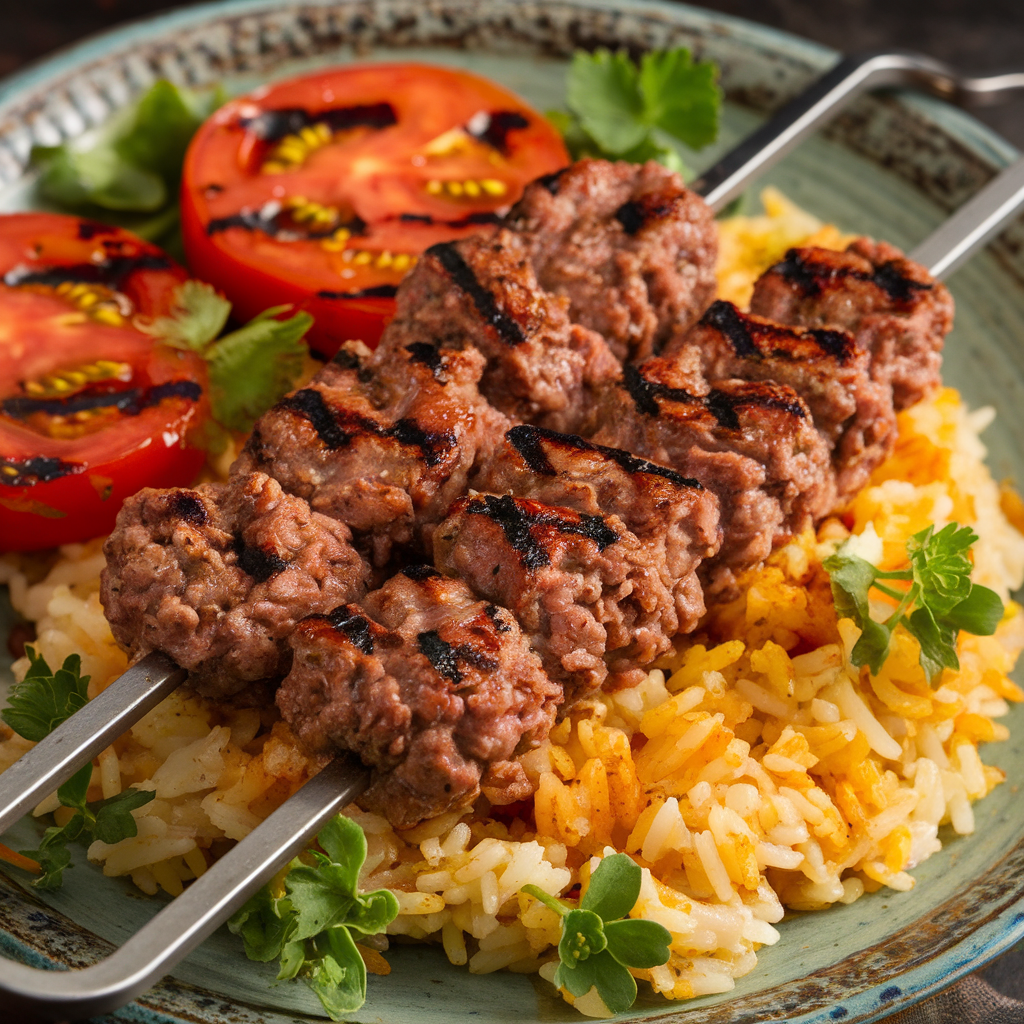
The Ingredients for a Perfect Koobideh Recipe
While the recipe for Kabob Koobideh varies slightly depending on regional preferences, the core ingredients remain the same. Here is a breakdown of what you’ll need to make this delicious dish:
- Ground Beef (or Lamb): The main ingredient of the dish. While beef is the most commonly used meat, lamb can also be used for a more authentic Persian flavor. The meat should be well-ground to ensure the mixture can bind together properly. A fat ratio of about 20% is ideal for a juicy and tender kebab.
- Onions: Grated or finely chopped onions are essential to keep the kebab moist and flavorful. The water from the onions helps to prevent the meat from becoming dry during grilling.
- Spices: The key spices in Kabob Koobideh include turmeric, cumin, salt, pepper, and sometimes sumac. These spices are part of the flavor profile that gives the kebab its signature taste.
- Saffron (Optional): Persian cuisine is known for its luxurious use of saffron, and adding a pinch of saffron to the meat mixture can elevate the flavor with its rich aroma and vibrant color.
- Parsley (Optional): A small amount of chopped parsley can be mixed in to add a hint of freshness and green color.
- Olive Oil or Butter: To ensure the meat mixture is moist, a little bit of fat, such as olive oil or melted butter, is often added.
- Skewers: Traditionally, metal skewers are used to cook Koobideh, though wooden skewers can also be used. If using wooden skewers, make sure to soak them in water beforehand to prevent them from burning on the grill.
How to Make Koobideh: A Step-by-Step Guide
Creating the perfect Kabob Koobideh may sound like an intricate process, but it’s a straightforward recipe that yields incredibly rewarding results. Follow this simple guide to achieve the ideal meat kebab.
Step 1: Preparing the Meat Mixture
- Grate or chop the onions finely. Place the grated onions in a cheesecloth or a fine sieve and press to extract as much moisture as possible. This step ensures the meat will stay juicy during grilling.
- Combine the meat with the spices. In a large mixing bowl, add the ground beef or lamb along with the grated onion, turmeric, cumin, salt, pepper, and any other optional ingredients (such as parsley and saffron). Mix everything together well until all the spices are evenly distributed throughout the meat.
- Knead the mixture. This is a crucial step. Knead the meat mixture for about 10 minutes. The goal is to build a sticky, cohesive texture that will hold together on the skewers. Kneading also helps to blend the flavors and ensures that the kebabs are tender.
- Add fat for moisture. If your meat seems dry, add a little olive oil or melted butter to the mixture to provide moisture and prevent the kebabs from being too tough.
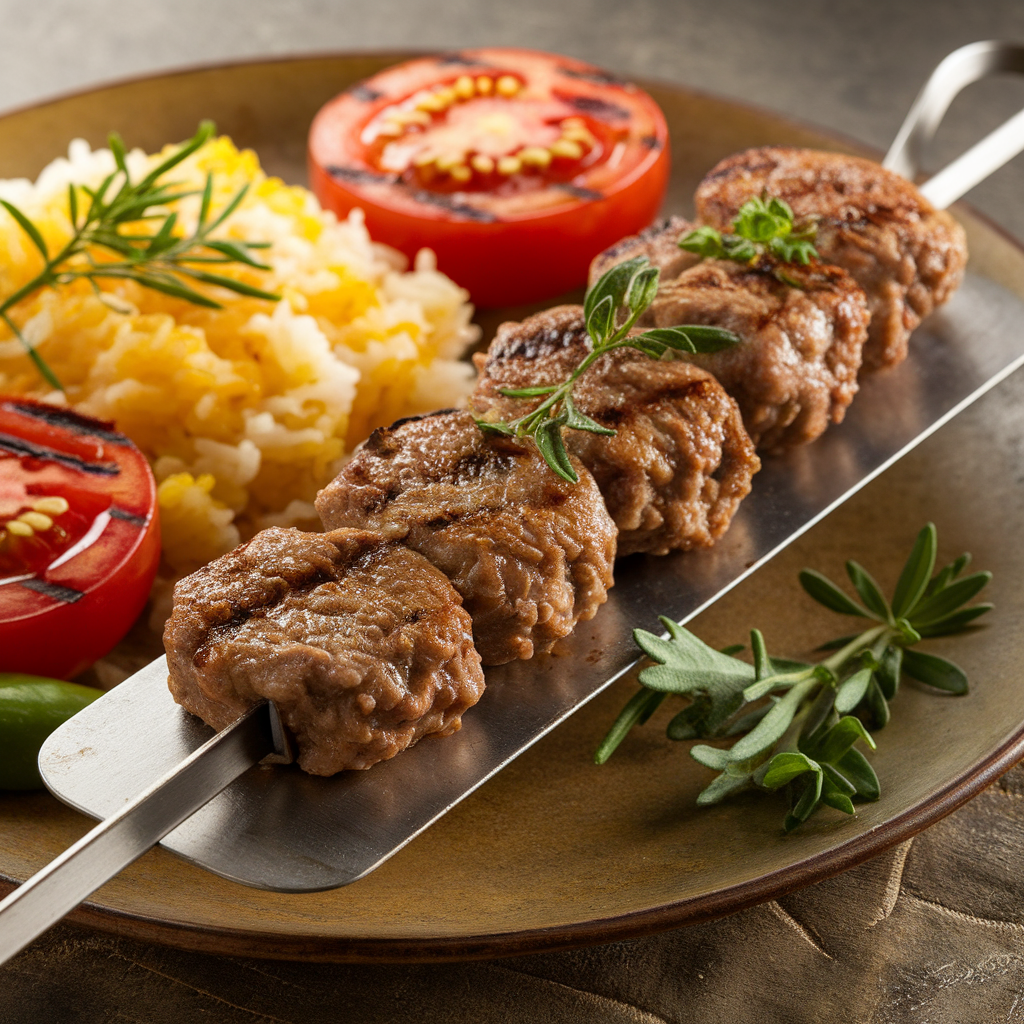
Step 2: Shaping the Kebabs
- Prepare your skewers. Lightly grease your skewers with some oil or cooking spray to prevent the meat from sticking.
- Form the kebabs. Take a handful of the meat mixture and mold it around the skewer, pressing the meat evenly along the length of the skewer. Aim to make the kebabs about 1 to 1.5 inches in thickness to ensure they cook evenly. Be sure to mold the meat tightly so it doesn’t fall off during grilling.
- Repeat the process until all the meat mixture has been shaped into kebabs on skewers. You can make several kebabs depending on the size of your skewers.
Step 3: Grilling the Koobideh Kebabs
- Preheat the grill. Prepare your grill by heating it to medium-high heat. If you’re using charcoal, let the coals burn down to a glowing, steady heat. If you’re using a gas grill, set it to medium-high heat.
- Grill the kebabs. Place the skewers on the grill and cook for about 4-5 minutes on each side, turning the skewers frequently to ensure that the meat cooks evenly. The key is to keep the grill at a steady temperature so that the kebabs cook through without burning on the outside.
- Check for doneness. The kebabs are ready when they are golden brown and have reached an internal temperature of 160°F (71°C) for ground beef. The meat should be juicy and tender, with a slightly crispy outer layer from the grill.
Step 4: Serving Kabob Koobideh
Serve your delicious Kabob Koobideh with:
- Persian rice (Chelo): Traditionally, Persian rice is served with kebabs, often accompanied by a dollop of saffron-infused butter on top.
- Flatbread (Lavash or Sangak): A piece of Persian flatbread is perfect for wrapping around the kebabs and enjoying with a variety of toppings.
- Grilled vegetables: You can serve the kebabs alongside grilled tomatoes, bell peppers, onions, and even eggplant.
- Yogurt dip (Mast-o-Khiar): A refreshing Persian yogurt dip made with cucumbers, herbs, and garlic pairs beautifully with Koobideh.
- Sumac: A tangy, red spice often sprinkled over the kebabs adds a nice contrast to the rich, savory flavors.
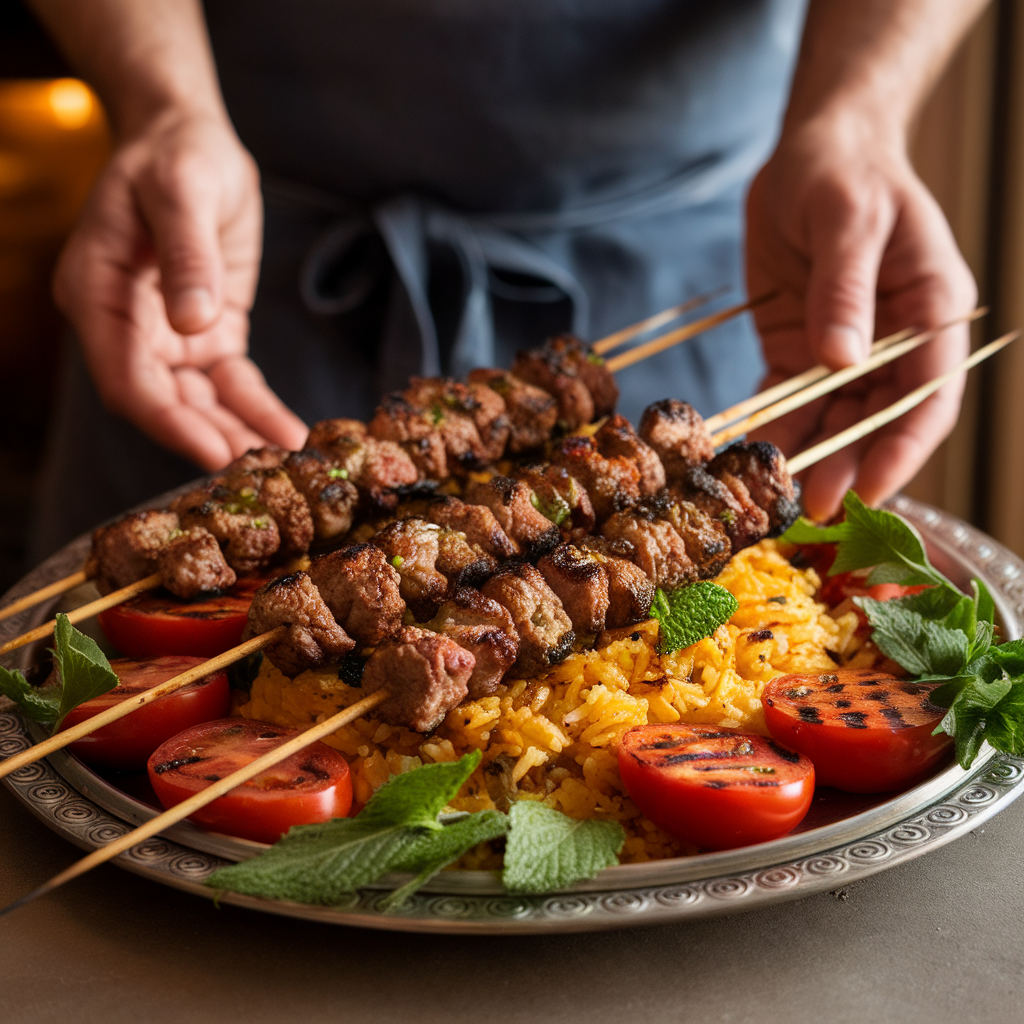
Koobideh Recipes Around the World
While Koobideh is deeply embedded in Iranian culture, it has inspired various adaptations in different parts of the world. From the Middle East to the West, this dish is celebrated in many ways.
- Kebab Recipes in the Middle East: Variations of the meat kebab can be found in many Middle Eastern countries, from Turkey to Lebanon to Afghanistan. The core ingredients remain the same, but regional spices and cooking methods provide unique twists on the classic Koobideh recipe.
- Meat Kebab in the West: In countries like the United States and the UK, Koobideh-inspired kebabs have made their way into mainstream cuisine. Persian restaurants and kebab shops serve these juicy kebabs to people of all backgrounds, introducing them to Iranian food and flavors.
- Food Iranian Culture: The shared love for kabobs connects people across nations. The history of Persian food transcends regional boundaries, offering a unique blend of spices, grilling techniques, and cultural influences.
Conclusion
Kabob Koobideh is a quintessential dish in Iranian cuisine. Its simplicity and richness in flavor make it a favorite in Persian homes and a must-try for anyone interested in exploring Iranian food. Whether you’re following an Iranian recipe for the first time or looking to perfect your existing method, this dish is sure to be a crowd-pleaser at any gathering.
By understanding the history, ingredients, and techniques behind Kabob Koobideh, you can appreciate not only the taste but also the cultural significance of this beloved Persian dish. So, fire up the grill, gather your ingredients, and enjoy the flavorful world of Iranian cuisine with a delicious serving of Kabob Koobideh!
